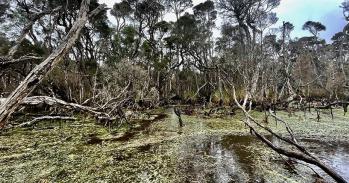
Central and northern Europe's first farmers were immigrants with barely any ancestral ties to the modern population, a study has found.
Central and northern Europe's first farmers were immigrants with barely any ancestral ties to the modern population, a study has found.
A new puzzle emerges, however. Neither the hunter-gatherers nor the early farmer DNA can account for all European genetic variants today. It seems we need to look for more major, unidentified migrations into, or within, prehistoric Europe.
Dr Peter Forster
Researchers used DNA taken from the remains of farmers who worked the land more than 7,000 years ago to discover that they were not related to the hunter-gatherers who inhabited Europe previously. Instead, they probably belonged to an immigrant population, possibly from south-eastern Europe.
The study also found that the ancient hunter-gatherers do share their predominant DNA type with some modern Europeans, unlike the agriculturalists who arrived in Europe at a later stage. Neither group, however, explains the genetic make-up of much of Europe's current population, which indicates that there were other waves of prehistoric migration that still remain uncharted.
The findings are being published in the journal Science and appear to resolve an enduring debate about how farming, one of the great "civilising" revolutions in human history, spread in Europe.
Generations of scholars have puzzled over whether the change in lifestyle from hunter-gatherer to farmer was brought to Europe by new people, or whether only the idea of farming spread. The new report provides persuasive evidence that it arrived in central Europe with a wave of immigrants approximately 7,500 years ago.
The study was led by academics from the University of Cambridge, Mainz University in Germany and University College London. Researchers compared new mitochondrial DNA (mtDNA) sequences from late European hunter-gatherers (up to 13,000 years old) with sequences from early farmers (7,500 years old), as well as with sequences from modern Europeans.
They found significant genetic differences between all three groups which cannot be explained by population continuity. Most (82%) of the hunter-gatherers share a genetic lineage known as "U", which is still found today in a minority of Europeans - about 5% of Mediterranean people, increasing northwards to 20-40% of traditional tribes in north-eastern Russia and Finland, such as the Saami.
The major DNA type among the farmers, however, was type N1a, which is exceptionally rare, found in less than 0.2% of the European population. The fact that this lineage was not shared with the hunter-gatherers means that the farmers were immigrants who, at least initially, did not mix with the existing population of Europe at the time.
"It is exciting to confirm that many Europeans today, especially in the north and north-east, carry ice-age hunter lineages," Dr Peter Forster, of the Cambridge Society for the Application of Research, Churchill College, University of Cambridge, said.
"A new puzzle emerges, however. Neither the hunter-gatherers nor the early farmer DNA can account for all European genetic variants today. It seems we need to look for more major, unidentified migrations into, or within, prehistoric Europe. These additional waves might have consisted of secondary farming movements or of later metalworkers."
Humans first arrived in Europe 45,000 years ago, replacing a Neanderthal population. A series of major climactic changes then ensued, including the last Ice Age. Hunter-gathering helped humans to survive through that period and was still in evidence 11,000 years ago, as the Ice Age ended. Within a few thousand years, however, it had largely disappeared, as the new wave of immigrants settled and domesticated plants and animals.
The study suggests that these farmers settled first in the Carpathian Basin. "It seems that farmers immigrated into Central Europe about 7,500 years ago, initially without mixing with local hunter-gatherers," Dr Barbara Bramanti, from Mainz University, said. "This is surprising, because there were cultural contacts between the locals and the immigrants, but, it appears, no genetic exchange."
Farming itself is believed to have begun in the Fertile Crescent of the Near East, between 12,000 and 7,000 years ago. Early communities there began to produce the so-called "founder crops", such as wheat and barley. More recently, it has become clear that early Chinese communities domesticated their own grains, such as rice and millet, independently of western influence and a growing body of research suggests that these methods may also have spread to the West.
"We are still searching for the remaining components of modern European ancestry," Professor Joachim Burger, from Mainz University, said. "Hunter-gatherer and early farmers alone are not enough. But new ancient DNA data from later periods in European prehistory may shed light on this in the future."
This work is licensed under a Creative Commons Licence. If you use this content on your site please link back to this page.





